
Goose of Hermogenes by Ithell Colquhoun
Mint condition (2003 edition)

“You can pluck someone like an instrument if you know the way to tune their heart.”
In May 1941, Ian Fleming of Naval Intelligence recruits Aleister Crowley to crack the recently captured Rudolf Hess by exploiting their mutual fascination with the occult. To fill in the background to Hess’s disastrous flight, Fleming provides the diary of Albrecht Haushofer, the deputy Führer’s assistant. 1945 finds Crowley in a boarding house in Hastings where he tutors Will, a fledgling priest, in Latin. Will stumbles on a file that reveals the devastating consequences of Crowley’s mission and discovers the true identities of the Reception Committee waiting for Hess in Scotland. Is the file genuine or a black-ops fake concocted by British Intelligence? Can a crazed rocket scientist in California supply the answer, or ‘M’, the Beast’s controller? Featuring Dion Fortune, Anthony Blunt, Hitler, Jack Parsons, and the Beatles, Aleister Crowley MI6 is a riveting spy thriller anchored in fact.
Aleister Crowley as himself in all his occult and charismatic glory – a manipulative, overbearing, bizarre yet compelling character. Fiction could hardly have invented him: he is a gift of a character to any novelist and Richard C McNeff has accepted him, unwrapped the parcel and given him his head. — Martin Booth (author of Crowley biography A Magick Life – on Aleister Crowley MI5).Aleister Crowley MI6
The Hess SolutionSynopsis
In May 1941, Ian Fleming of Naval Intelligence lunches with Aleister Crowley in a Mayfair hotel. Fleming wants the Beast to crack the recently captured Rudolf Hess by exploiting their mutual fascination with the occult. He gives Crowley the diary of Albrecht Haushofer, Hess’s principal adviser, which fills in the background to the deputy führer’s disastrous flight.
In 1945, Crowley moves to Netherwood, a boarding house in Hastings and tutors Will, the teenage handyman who intends to become a Catholic priest, in Latin. Left alone in Crowley’s room, Will stumbles on a file that describes the Beast’s wartime encounter with Hess. Believing Crowley is Churchill, Hess reveals the date of the attack on Russia. Bent on revenge, Polish troops attack Hess’s Surrey prison and shoot him dead. MI6 decide to substitute a double.
Several visitors come to Netherwood: Dion Fortune, the occultist; Lady Frieda Harris, creator of the Thoth Tarot paintings; a female professor researching a book on magicians; John Symonds, the Beast’s future biographer; and a pupil of Crowley called Maxwell Knight, in fact the spymaster ‘M’ who runs a division of MI5. Meanwhile, in a German castle, another MI5 operative, Anthony Blunt, burns correspondence that implicates the Duke of Kent in Hess’s mission. A Hungarian professor and his wife come to stay at Netherwood, in fact Soviet agents hunting the Hess file.
Will is the victim of a honeytrap and agrees to fetch it. He discloses the plot to ‘M’. At the handover, commandos ambush and kill the couple. In disgust, Will renounces the idea of becoming a priest. Crowley dies at Netherwood in 1947. ‘M’ tells Will that Crowley has sent the Hess file to Jack Parsons, an American disciple and rocket scientist.
In 1952, Will visits him and his wife Cameron in Pasadena. He and Jack perform an Enochian ritual in the desert. Ten days later Parsons blows himself up before he can give Will the file as promised. In April 1965, Will is working in the music business. The year is one of rapid growth for the counterculture that Crowley prophesied. Will works with the bandleader Graham Bond, who claims to be Crowley’s son. Later, in a Soho club, Will encounters John Lennon and George Harrison on their first LSD trip.
The next day he runs into Maxwell Knight who tells him the Hess File was fabricated by Fleming. In May Knight invites Will to his suburban home. Will comes across a photo taken at Hess’s Scottish destination which reveals the true identities of the reception committee awaiting him.
Notes For Editors: About Richard C McNeff: Richard C McNeff is the author of the cult short story ‘Sybarite among the Shadows’ which grew into the occult and espionage-themed novel, Aleister Crowley MI5. He also wrote the memoir, With Barry Flanagan: Travels through Time and Spain, and the satire, The Dream of Boris. He is a contributor to the Guardian, Fortean Times, Wormwood and Boulevard Magenta. He has lived in Barcelona, the Basque Country, Ibiza and Baku. He was born in London, his current home.
About Aleister Crowley
About Mandrake: Independent publisher of essential occultural books – covers of most of its current, in-print titles are shown here.
Links:
Download assets. Media contact: Diane M. Hinds, Tel: 020 7748 3003 or email: info@TEBagency.biz.
Diane M. Hinds, MA, BAJ
The Entertainment Bureau Ltd5 The CrescentLondon, NW2 6HAMob: +44 77 6668 3003
-o0o-
The Entertainment Bureau Inc8605 Santa Monica BlvdPMB 15509West HollywoodCalifornia, 90069-4109United States
Tel: +1 323 284 5056
This email contains confidential information belonging to the sender which is legally privileged. It is believed to be free of viruses which may affect any IT system. It is the responsibility of the recipient to ensure that any emails or attachments are virus free as The Entertainment Bureau Ltd accept no responsibility. Should you not be the intended recipient then any disclosure, copying, distribution or the taking of any action in reliance on the contents of this email is strictly prohibited. If you have received this transmission in error, please notify the sender immediately and permanently delete this message. Registered Office: ℅ Brookscity Ltd 6th Floor 71-75 Shelton Street. London WC2H 9JQ Company No: 08830811
Dita Von Teese
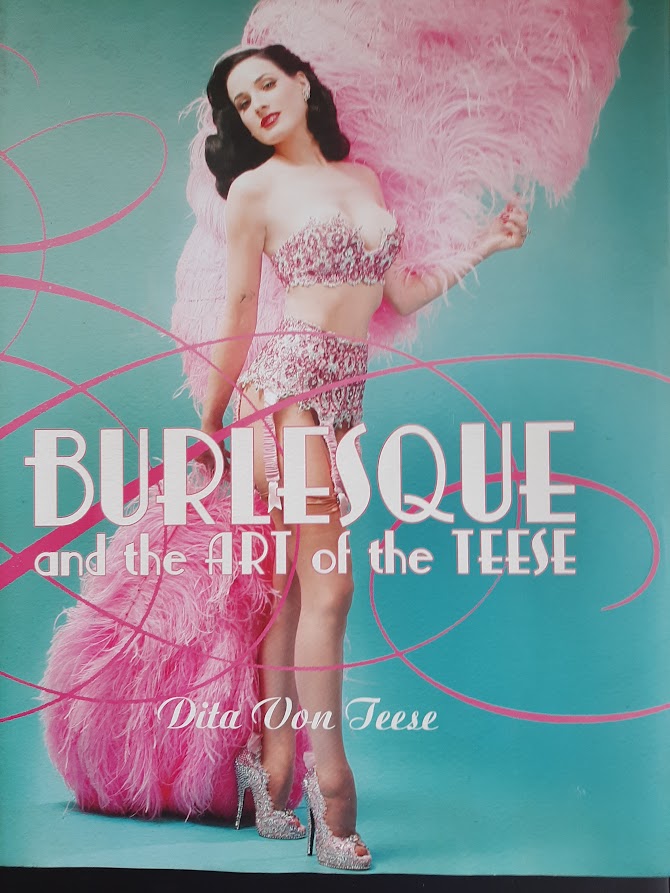
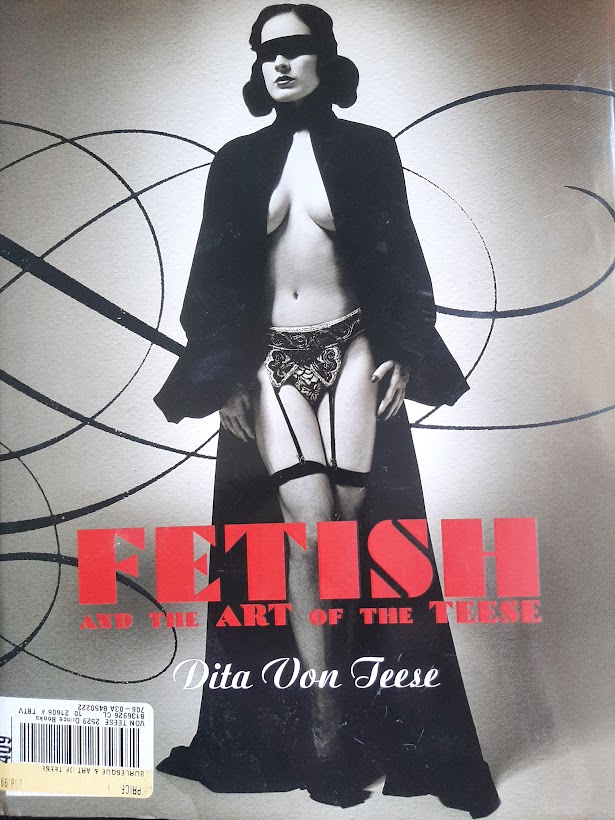
Special Dos-a-Dos edition (2006) of Dita Von Teese Burlesque and the Art of the Teese and Fetish and the Art of Tees
Dita Von Teese is the undisputed Queen of Burlesque.
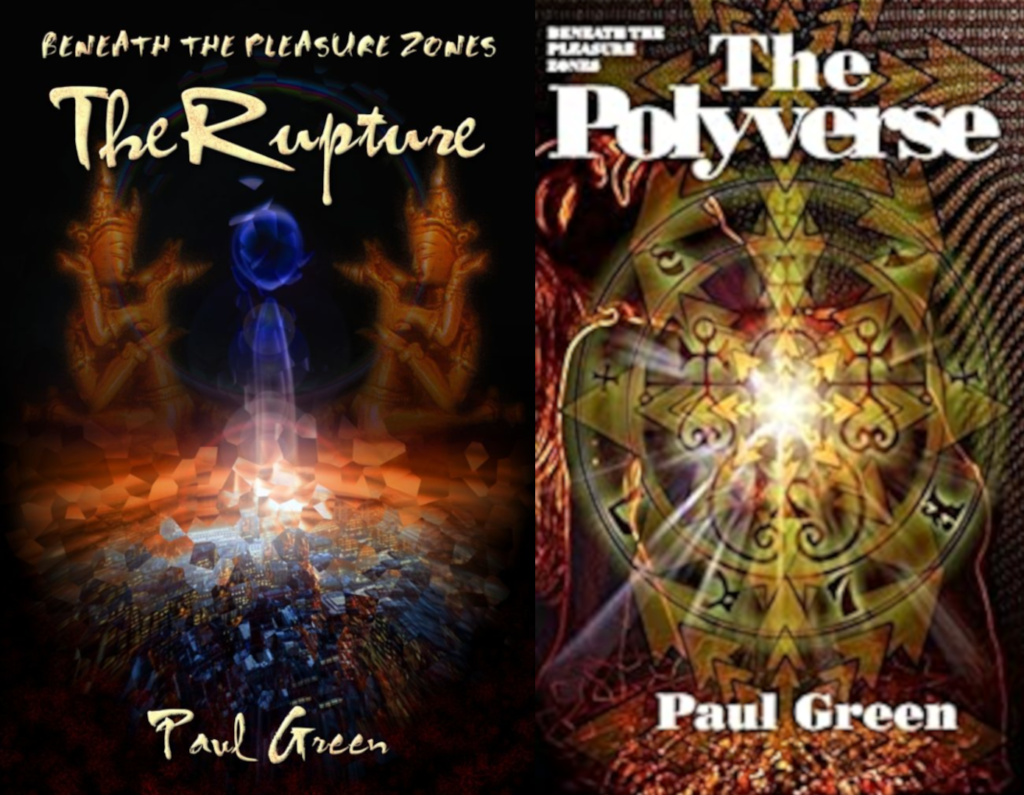
Get The Rupture & The Polyverse for only £12.99 / UK
Get The Rupture & The Polyverse for only $19.99 / USA /AUS
Beneath The Pleasure Zones – The Rupture and Beneath The Pleasure Zones – The Polyverse are extensions of Paul Green first novel The Qliphoth in that they share the same protagonist Lucas, whose youthful dabblings have released the Qliphothic forces of chaos and fractured the reality of everyday Britain. But both Pleasure Zones books can be read independently. In The Rupture, an oligarch builds a cybernetic virtual reality complex on an ancient site in the middle of a rural neo-pagan community of warlocks, who are also besieged by fundamentalist militias. As a consequence, inThe Polyverse the Lobe (aka the internet) generates its own demonic entities, the prankster Quantum Brothers, who create further ordeals for Lucas and the two women in his life Viv and Carla. There’s apocalyptic destruction but also a glimmer of hope…
Richard Ward
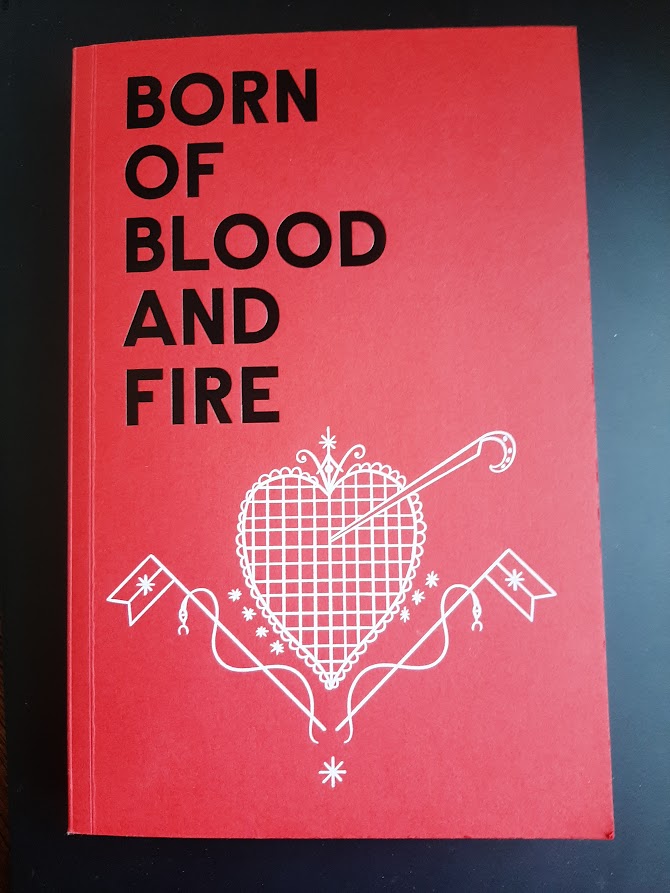
ISBN: 9781912316441
Condition: Very good
The origins, evolution, history and practices of the Haitian Petwo Rite.
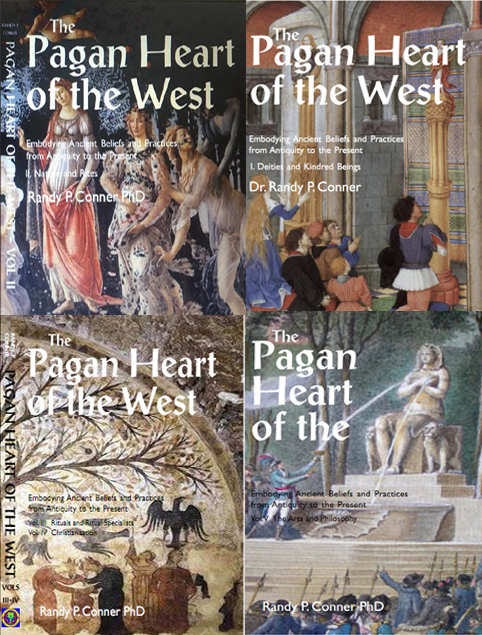
Get Pagan Heart of The West Quartet for only £65.00 postage free / UK
Get Pagan Heart of The West Quartet for only $93.00 postage free / USA / AUS

Get the Enochian Chess Trilogy for only £70.00 postage free / UK
Get the Enochian Chess Trilogy for only $90.00 postage free / USA & Elsewhere
Khemetic Enochian ChessRosicrucian Chess of The Golden Dawn
Enochian Chess Series Vol.I
Steve Nichols
– over 200 illustrations many in colour.
ISBN: 978-1-906958-78-7
US$39.99 / UK£30.00
Khemetic Enochian Chess
Hypermodern Magick
Steve Nichols
Illustrations many in colour.
ISBN: 978-1-906958-86-2
US$39.99 / UK£30.00

Get the audiobook bundle of both titles Three Wishes & Graduates Sex in The Early 1970s, for a £1.00
Click HERE for the audiobook
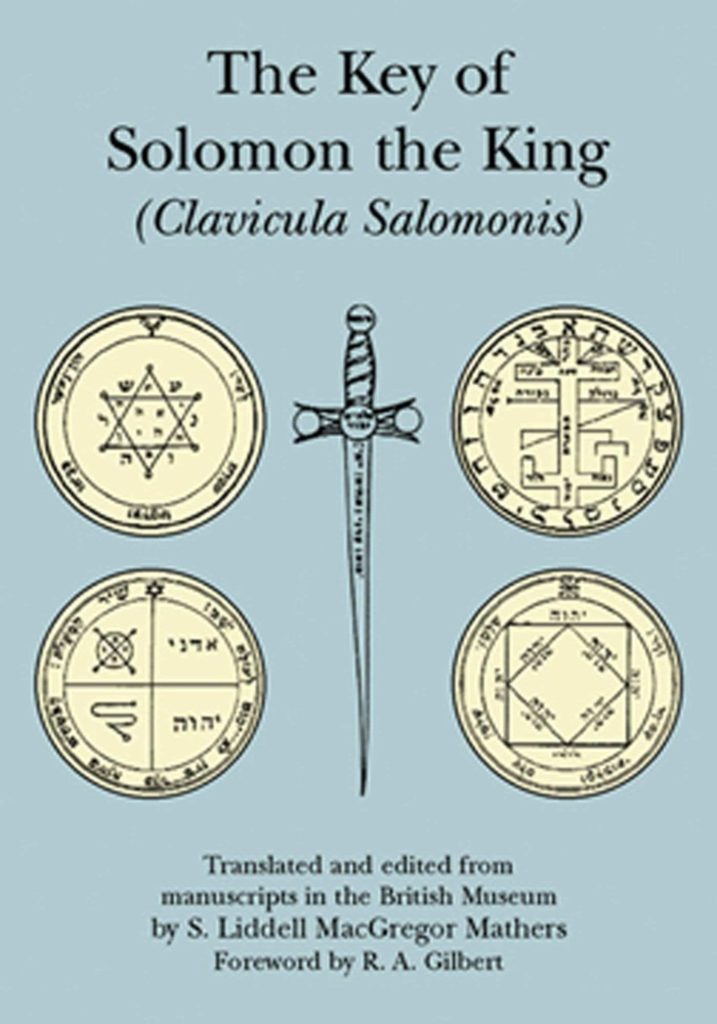
The Key of Solomon the King
ISBN 9780877288473
Condition: New
The work is traditionally divided into two books detailing the Key of King Solomon. Book One explains the operation of conjurations, curses, spells and other magical works. Book Two instructs the practitioner on the proper attire, purification rituals and other means of obtaining the goals of the Goetia. Between these two books is the list of plates that contain numerous illustrations and secret seals of Solomon, including the Mystical Seal of Solomon, the Pentacles of Solomon, and the Mystical Alphabet, which impart the mechanisms and requirements for the invocation of spirits and demons and other magical works or spells.
Sometimes referred to as the Greater Key of Solomon, this work should not be confused with the Lesser Key of Solomon or Clavicula Salomonis Regis, or Lemegeton, which is based on similar source material and was also researched by S. L. MacGregor Mathers with the aid of Aleister Crowley. It is thought that The Greater Key of Solomon later inspired The Lesser Key as a derivative work: one with its own substantial value through the addition of various illustrations and guides such as the Magic Circle of Solomon, the 72 Seals of Solomon or King Solomon Seals, and the Pentagram of Solomon. But, although both grimoires are inspired by the same material, they are separate and distinct works.
It is important to note the Solomon Key is not any one particular book. The material has been collected in various forms and published by many authors, including Armand Delatte, and L. W. de Laurence. The earliest versions of the text can be found in ancient manuscripts in different languages all dating from the 16th century or later and spread across the globe in various libraries or private collections. For example, a Hebrew edition survives in the British Library, while a Latin version is kept at the University of Wisconsin. Various French editions as well as English translations are located throughout the world.
According to the mythical history of the document, King Solomon wrote the book for his son Rehoboam and commanded him to hide the book in his sepulchre upon his death. After many years, the book was discovered by a group of Babylonian philosophers repairing Solomon’s tomb. None could interpret the text until one of them, Iohé Grevis, suggested that they should entreat the Lord for understanding. The Angel of the Lord appeared to him and extracted a promise that he would keep the text hidden from the unworthy and the wicked, after which he was able to read it plainly. Iohé Grevis then placed a conjuration on the book preventing the unworthy, unwise, and godless from attaining the desired effect of its practices.
Scholars however believe the work and its many iterations derive from the ancient practices of Jewish Kabbalah and Arab Alchemy. After time, it is thought Greek and Roman influences were added until, finally, the work was used and molded by high Renaissance magicians. This book, as well as other King Solomon books, such as the Magical Treatise of King Solomon and the Testament of Solomon, were brought back to modern times through the labors of occult practitioners such as S. L. MacGregor Mathers and others around the turn of the last century.
Old 1st Paperback edition
BUY IT NOW for only £5
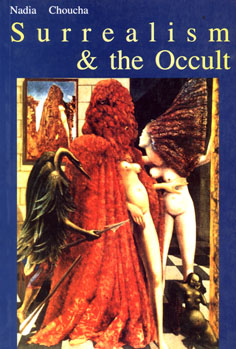
Surrealism & The Occult
Nadia Choucha
Format: Softcover/164 pp.
ISBN: 9781906958749
£11.99/US$20
Subjects: Art/Art History/Surrealism/Occult.
Many people associate Surrealism with politics, but it was also permeated by occult ideas, a fact often overlooked by art historians. This occult influence goes beyond general themes to the movement’s very heart.
This occult influence goes beyond general themes to the movement’s very heart. The antinomian stance of Surrealism can be traced directly to the influence of radical nineteenth century magi such as Eliphas Lévi, whose Dogma and Ritual of High Magic was widely read by Surrealism’s ideologues. Amongst these we find its progenitor André Breton.
The book shows how many Surrealists and their predecessors were steeped in magical ideas: Kandinsky, with his involvement with Theosophy, the sorcery of Salvador Dali; the alchemy of Pablo Picasso and the shamanism of Max Ernst and Leonora Carrington.
Surrealism did not establish itself in Britain until the 1930s but a select few felt something in the air. Almost ten years before the Surrealist experiments with automatic drawing, an obscure English artist, Austin Osman Spare had perfected the technique.
Nadia Choucha shows, convincingly, that occult and surrealist philosophies were often interchangeable. Surrealism and the Occult is seminal reading for art historians and occultists alike, while artists will find it a vital guide to the unlocking of the imagination.
Praise for Nadia Choucha’s Surrealism & the Occult
”Highly readable…seminal… fascinating” – Francis X. King
”alive, with the heady mixture of occult and pictorial symbolism treated with laudable lucidity.”- Art Book News

The Magical Dilemma of Victor Neuburg
Jean Overton Fuller
Format: Softcover
ISBN:
£13.99/US$24
Subjects: Biography/Aleister Crowley/Thelema/Magick.
To mark the centenary of Dylan Thomas, here’s an extract from JOF’s book that narrates her first meeting with the soon to be famous poet:
“We agreed to Zoists”: Dylan Thomas & the Occultist Victor Neuburg (Aleister Crowley’s lover & collaborator)
“We agreed to Zoists.
Runia wanted us to have badges, ‘so that one Zoist can recognize another, if you meet outside, or if we have provincial centres.’
There was a murmur of dissent. Some of us felt this thing was getting inflated. And we didn’t want badges. We weren’t boy scouts; just a few people who wanted to come here and sit and talk to each other on Saturday evenings.
‘All right, no badges,’ she said. ‘But it is agreed we have a name?’
It was agreed but there was no enthusiasm for the name, our feeling being for the informal. Before we left Runia made us cups of tea.
When eventually we broke up, and I stood again in the road outside, I felt I could tell my mother I had been among distinguished people. But the truth was I felt something else as well. I felt I had been in ancient Egypt and for this feeling I could find no explanation.
Not all of those who had been present on the first evening returned the following Saturday, but as I attended every week I began to know the regulars. Arriving soon after 8 (dinner at the hotel where my mother and I lived, was at 7, so it was a rush), I always found a certain number of people there already, though there was usually some time to wait until Vicky and Runia came from the inner room. It was in this waiting time that I had to find my feet, as it were among the other young ones. Nobody was ever introduced at Vicky’s. One just found out for oneself. I did not find the young men easy although they made efforts to draw me into the circle, for they assumed an acquaintance with modern poetry and political authors greater than I possessed; I could not always follow their allusions, and I had the feeling they all participated in a form of culture slightly strange to me. I was therefore grateful when a good looking young man, quiet mannered and of a more ordinarily civilized demeanour, settled himself beside me and asked, simply, ‘How did you come to Vicky’s?’
I told him about the circular letter I had received. He knew Geoffrey Lloyd had sent some out and asked, ‘What do you do when you’re not writing poems for Vicky? What’s your background, so to speak?’
I told him I had been on the stage since I was seventeen.
He said ‘Fancy our having an actress among us!’
‘What’s your name?’ I asked him.
‘William Thomas’, was what I first thought he said, but then he added, ‘It’s a special Welsh name.’
There could be nothing very special about William, and I puckered my brows.
‘You’ll never have heard it before,’ he said. ‘Nobody in England ever has. It should really be pronounced Wullam, in Welsh.’ Or was he saying ‘Dullan’?
‘It’s a special Welsh name,’ he repeated. ‘I shall have to spell it for you. D-Y-L-A-N. In Wales, it’s pronounced Dullan. But I’d been corresponding with Vicky for some time before I came to London, and when I arrived I found he had been calling me Dillan, in his mind. I thought if Vicky didn’t know how to pronounce it nobody in England would, so I decided to take it as the standard English pronunciation of my name. Otherwise I’d spend all my time telling people it was Dull and not Dill, and I think perhaps Dillan sounds more elegant than Dullan. Only Idris objects and thinks it’s frightfully fancy! Because he’s Welsh, too, and he knows! but now I’m getting even Idris trained to call me Dillan, though it’s under protest!’
‘What part of Wales do you come from?’ I said.
‘Oh, I only come from a small town. Swansea.’
Whereas I had previously felt myself to be the most naive member of a group otherwise composed of sophisticated, bohemian intellectuals, I now felt I had, vis-à-vis Dylan Thomas, at any rate, an advantage in being a Londoner. ‘I should have thought Swansea was a large town,’ I said. ‘I was near there all last summer. If you had been to the theatre at Porthcawl you would have seen me on the stage!’
‘No, I’m afraid I didn’t’ he said. ‘What a pity!’
Giving the conversation a turn he did not expect, I said, ‘Have you ever been down a mine?’
‘No.’
‘I have!’ I explained triumphantly. ‘Near Crumlin. I once played a January date in the Rhondda. Or more exactly the Ebbw Vale.’ I told him how I had persuaded the men at a pit to take me down the shaft, and how, having arrived at the bottom, I was given a lamp to hold and escorted along a passage which had been hewed through the coal to a point where it became so low that one would have had to proceed on hands and knees. I was shown a fault seam, which I felt with my fingers.
‘You have seen something in Wales which I haven’t!’ said Dylan. He explained that his home was some distance from the mining regions. He described the part of Swansea where he lived, with a detail I cannot now recall, except that it sounded salubrious and agreeable. His father was Senior English Master at the Grammar School. ‘Living where I do one doesn’t really see anything of all that,’ he said, with reference to my allusion to the coal mining (and depressed) areas. ‘Idris comes from the Rhondda,’1 he said. ‘I haven’t been into those areas.’ As though he had been slightly shamed by my adventure, he added, ‘Perhaps I ought to have done.’
‘It’s because you live there that you wouldn’t think of it,’ I said. ‘When one is touring one feels one must see everything in case one never comes again. When I was sixteen, my mother and I made a tour of Italy, Pisa, Rome, Naples, Capri, and back through Perugia, Florence and Milan. We felt we had to go into everything, even the smallest church we passed on any street. We realized we had never “done” London half as thoroughly because we took it for granted.’
I have no ‘outrageous’ sayings of Dylan Thomas to record. His conversation with me was perfectly drawing-room and unexceptional. I remember him as a polite young man. Friendly, but not at all presuming.
He told me the origins of the circle of which I now formed part. ‘First one and then another of us found our way to Vicky’s through entering into correspondence with him or something like that, and so a circle grew up around Vicky. We’re all very fond of Vicky.’ He explained that, ‘always reading each other’s names in print we began to wonder what the ones whom we hadn’t seen were like.’ So they had had the idea ‘of sending out circulars to everybody who was a contributor. He thought it had brought in some interesting people. ‘Well, it has brought you!’ Perhaps one could name some kind of a regular thing of it. ‘The only thing I don’t like is the name Zoists!’ he said.
I laughed and said, ‘It does sound a bit like protozoa, zoophytes and zoids!’
Dylan pulled a funny face.
‘We’re always called “Vicky’s children”,’ said Dylan. ‘It’s a bit sentimental, but I don’t think we shall ever be called anything else.’
It had been at the back of my mind while he was speaking that his name, as he had spelled it out, was one which I had read in the Sunday Referee in a context more important than that of the weekly prizes. I had not taken the paper regularly before I joined the circle, or I would have known the whole build-up. I said, ‘Aren’t you the winner of a big prize? I believe you’re one of the distinguished people here!’
‘It was through Vicky and the Sunday Referee that a book of my poems has been published,’ he said. He explained that a prize was offered twice yearly, part of which consisted in the publication of the winner’s poems in book form. ‘The first was awarded to Pamela Hansford Johnson. She isn’t here tonight. I was given the second of them.’ He said that Vicky had helped him pick out what he thought were the best of the poems he had written.
‘What’s it called?’
‘Just 18 Poems. It was published just before Christmas, and I think it’s doing quite well.’ He added, ‘I’m very grateful to Vicky. It’s a big thing for me. One’s first book is the most difficult to get published. Everyone says so. Now that I have one book published, it should be easier to get the next accepted, perhaps by an ordinary firm.’
My sentiment for Vicky was already so strong that I was slightly shocked.
Dylan Thomas saw it. ‘Vicky doesn’t expect us to stay with him!’ he said. ‘This is a nursery school from which we are expected to go out into the world. When we can get published elsewhere nobody is more pleased than Vicky!’
Just then the moment for which we had been waiting arrived. The door from the inner part of the house opened and our hosts came out to join us.
Vicky came straight up to Dylan and me. I did not know which of us the distinction was meant for but it gave me joy. He stood by my chair, looking down on us beamingly, and said to Dylan, ‘You’re entertaining this little lady?’
Dylan said, ‘I’ve been telling her something of the history of the Poet’s Corner.’
*********************************
Laugharne,
Carmarthenshire,
Wales
19 June 1940
Dear Miss Fuller
I haven’t heard anything from Vicky and Runia for years, until about a fortnight ago.
Then Pamela Johnson wrote to tell me that Vicky had just died. I was very grieved to hear it; he was a sweet, wise man. Runia’s address is 84, Boundary Road, NW8. At least, I suppose she is still there. I wrote her a letter, but I haven’t had a reply yet; probably she’s too sad to write.
Yours sincerely
Dylan Thomas
——————————
Really two books in one. Firstly a record of one man’s extraordinary journey to magical enlightenment. Secondly the story of Aleister Crowley, the magus who summoned Neuburg to join him in the quest.
‘The book opens with the author’s entry into the group of young poets including Dylan Thomas and Pamela Hansford Johnson. They gather around Victor Newburg in 1935 when he is poetry editor of the Sunday Referee. Gradually the author becomes aware of his strange and sinister past, in which Neuburg was associated in magick with Aleister Crowley.
Contents: Beginnings / Mystic of the Agnostic Journal / Crowley and the Golden Dawn / Initiation / Magical Retirement / Equinox and Algeria / Rites of Eleusis / Triumph of Pan / Desert / Triangles / Moon Above the Tower / Templars and the Tradition of Sheikh El Djebel / Paris Working / The Sanctuary / Arcanum Arcanorum / Dylan Thomas
REVIEWS
‘Those interested in Western occult history will welcome this revised and expanded edition of an important work first published in 1965.
Overton Fuller’s biography of Neuburg paints an intimate portrait of this complex character who was as much mystic as poet. A prominent figure in London’s literary bohemia in the 1930s, Neuburg encouraged such writers as Dylan Thomas, Pamela Hansford Johnson, Hugo Manning and many others, including Overton Fuller.
In his earlier days, Neuburg had been a disciple, magical partner and possibly even lover of Aleister Crowley during a period of ground-breaking magical experiments.
‘Vicky encouraged me as no one else has done,’ Dylan Thomas declared on hearing of Neuburg’s death. ‘He possessed many kinds of genius, and not the least was his genius for drawing to himself, by his wisdom, graveness, great humour and innocence, a feeling of trust and love, that won’t ever be forgotten.’ ‘ . . . there was a whiff of sulphur abroad, and all of us would have liked to know the truth of the Aleister Crowley’s legends, the truth of the witch-like baroness called Cremers, the abandonment of Neuburg in the desert.’
– Pamela Hansford Johnson
‘No dry biography this but an illuminating and compelling account of a multi-faceted personality who lived during an exciting period of occult and literary history. An absolute must-have!’
– (ME) In Prediction Magazine November 2005
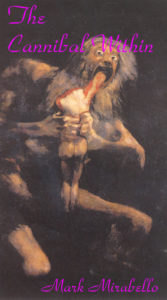
The Cannibal Within
Mark L. Mirabello
Format: Softcover
ISBN: 9781869928278
£9.99/US$16
Subjects: Cosmic Horror/Horror Fiction.
–
Best New Horror 2003, from The Mammoth Book of Best New Horror: vol. 14. Edited by Stephen Jones, 2003 Edition, ISBN 0786712376.
They raped me and ate my friend alive.’ Thus starts this work of erotic horror fiction filled with ‘sacrilege, blasphemy, and crime’–written in a style that is part H. P. Lovecraft, part Marquis de Sade, and part Octave Mirbeau–The Cannibal Within is literally ‘wet with sin, slippery with blood, and slimy with fornication.’
The novel’s central character is part Lara Croft part Sarah Connor. She/We has a choice: the evil may be patiently borne or savagely resisted.
We may think we are special–holy, honored, valued–god’s chosen primates–but that is a fraud. The dupes of superhuman forces, we are misfits and abominations. We have no higher purpose –no savior god died for our sins–we exist, only because our masters are infatuated with our meat.
‘The Earth is a farm,’ wrote Charles Fort.
‘We are someone else’s property.’
‘–no savior god died for our sins–we exist, only because our masters are infatuated with our meat.’
‘We have a choice: the evil may be patiently borne or savagely resisted.’
‘. . .one of the most unique horror novels to come along in a long time.’
– Dark Funeral
Reviewed by Tyler Ferguson in Dagobert’s Revenge
‘While at face value the horror fiction genre may seem to be the right label to list this book under, we may find more than fiction lying under the surface. The author, a History professor at Shawnee State University in Portsmouth, OH, has created a work that can be described as terrifying, revolting, sadistic and even fascinating. I prefer to describe it as fascinatingly terrifying, revolting, sadistic and somewhat familiar in an archetypal sense. The book makes the reader want to gasp and turn away, but it appeals to one’s morbid curiosity so well that you cannot but read on, because waiting for you is a horrific reality that you pray is only fiction. And in this (hopefully) fictitious reality you will find truth and secrets you are not ready for.
On the surface the book relates an encounter between the author and a strange women who wants to tell her story. The woman, obviously disturbed, begins to recount to the author a story involving her and her friend Maddalena. The story takes place on October 13, 1972 in Point Pleasant, West Virginia. Readers might recognize this as a setting of other notorious paranormal occurrences. Quite literally, the woman tells of the time she met God – or gods in this case. However, these gods do not follow our common idea of what a god should be. These gods are the gods of old; the jealous, lustful rulers of a forgotten past. Maybe they are the “watchers” or the reptilian deities so many pages have been devoted to. The author doesn’t clarify this point but tells us that they are the “Master Species”, a race driven by lust and hunger. And to them, humans satisfy both desires. These monsters seduce our main character and her friend by appearing in a form that they would assuredly trust, gaining that trust until they show their true nature. This is when the horror begins.
The author spares no detail in relating what the woman told him. The monsters tortured and ate her friend while she was being raped. The author goes on to recount the years our main character spent in captivity living in a subterranean world with the beasts. He describes the society and habitat of these creatures and their true intentions. Reader beware: we are spared no savage detail. As the book ends, the author tells of his last encounter with the woman and finally we realize our own horrifying destiny.
Now we must examine what hides in the dark corners of this book. The author himelf commented that, “This book is about violation in every form. In an occult context – in a style that is part H.P. Lovecraft, part Octave Mirbeau, and part Marquis De Sade, it explores crime, depravity, and madness. Some who penetrate the darkness will find illumination; others will simply despise and judge.” Read this book for only the superficial story and you have missed it entirely. The author has hidden in the text occult philosophies that many have spent lifetimes trying to understand. I tell you to read this book with your eyes open to the mysteries that are hidden on every page. I will not spoil the quest that I am sure the author hopes we undertake, but I can tell you that in this book are hidden the secrets of some of the world’s greatest societies, ideas and truths of a forgotten time, tenets of religions long believed dead, and observations of our world many know but are afraid to face. A poet once wrote:
” I used to see forever.
My future was mine.
My ideas were powerful.
Fear and hatred changes all.
I gave a body to them
Their return was a corpse.
Promises that never spoke.
But give more, they ask.
More of my death, which they began.
Do they always empty your head?
What gods that came for love
Then killed for selfish lust.
Lust, that is what they had.
Humans, the food that satisfies the thankless gods.”
‘I highly recommend adding The Cannibal Within to your occult collection.
Place it on a shelf alongside Alcheishe Bruiloft van Christiaan Rozenkruis and read it in the same manner.’
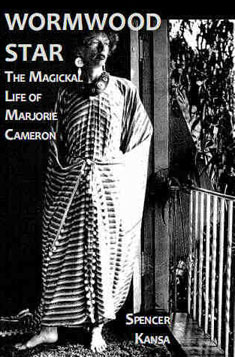
Wormwood Star
The Magickal Life of Marjorie Cameron
Spencer Kansa
Format: Softcover/302 pp/illustrated.
ISBN: ISBN 978-1-906958-60-2 (was 978-1-906958-08-4)
£13.99/US$24
Subjects: Biography/Magick/Thelema/Art/American Underground/Film Studies.
In the first-ever biography written about her, Wormwood Star traces the extraordinary life of the enigmatic artist Marjorie Cameron, one of the most fascinating figures to emerge from the American Underground art world and film scene.
Born in Belle Plaine, Iowa, in 1922, Cameron’s uniqueness and talent as a natural-born artist was evident to those around her early on in life. During World War 2 she served in the Women’s Navy and worked in Washington as an aide to the Joint Chiefs of Staff. But it was after the War that her life really took off when she met her husband Jack Parsons. By day Parsons was a brilliant rocket scientist, but by night he was Master of the Agape Lodge, a fraternal magickal order, whose head was the most famous magus of the 20th century… Aleister Crowley.
Gradually, over the course of their marriage, Parsons initiated Cameron into the occult sciences, and the biography offers a fresh perspective on her role in the infamous Babalon Working magick rituals Parsons conducted with the future founder of Scientology, L Ron Hubbard. Following Parsons death in 1952 from a chemical explosion, Cameron inherited her husband’s magickal mantle and embarked on a lifelong spiritual quest, a journey reflected in the otherworldly images she depicted, many of them drawn from the Elemental Kingdom and astral plane.
Throughout the 1950s and 1960s, Cameron became a celebrated personality in California’s underground art world and film scene. In 1954 she starred in Kenneth Anger’s visual masterwork, Inauguration of the Pleasure Dome, stealing the show from her co-star Anais Nin. The budding filmmaker Curtis Harrington was so taken with Cameron, he made a film study dedicated to her artwork entitled The Wormwood Star. He then brought Cameron’s powerful and mysterious presence to bear on his evocative noir thriller, Night Tide, casting her alongside a young Dennis Hopper.
Cameron was an inspirational figure to the many artists and poets that congregated around Wallace Berman’s Semina scene, and in 1957 Berman’s show at the Ferus Gallery was shut down by LA’s vice squad, due to the sexually charged nature of one of her drawings. Undaunted, she continued to carve a unique and brilliant path as an artist.
A retrospective of Cameron’s work, entitled The Pearl of Reprisal, was held at LA’s Barnsdall Art Park in 1989, and after her death, some of her most admired pieces were included in the Reflections of a New Aeon Exhibition at the Eleven Seven Gallery in Long Beach, California. Cameron’s famous Peyote Vision drawing made its way into the Beat Culture and the New America retrospective held at the Whitney Museum in 1995. And in 2006, a profile of her work was featured in the critically lauded Semina Culture Exhibition. The following year an exhibition of her sketches and drawings was held at the Nicole Klagsbrun Gallery in New York.
With so much of her life and work shrouded in mystery, Wormwood Star sheds new light on this most remarkable artist and elusive occult icon.
All Material on this page copyright © Spencer Kansa
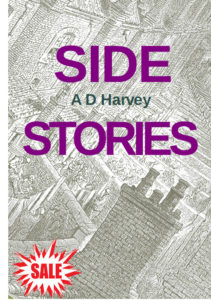
Collected here for the first time, are the masterly short stories of A D Harvey, many of them erotic, some of them distinctly odd, and a couple downright lewd. Linked together they, like a novel, shed light on one of the less conventional scholarly careers of recent times.
In 2013 more than eighty Internet sites round the world took up the story of A.D.Harvey’s literary spoofs following his outing in The Times Literary Supplement, thereby further outraging an academic establishment which had had it in for him ever since he had broken ranks by obtaining a Ph.D. at Cambridge only six years after sitting his A-levels. The author of eight scholarly monographs, numerous articles in academic quarterlies, three novels and a slim volume of verse, A.D.Harvey is (despite occasional spoofs) a serious if sometimes idiosyncratic writer and his gift for style, cogency and psychological insight is demonstrated by a collection of his short stories and other pieces now published under the title Side Stories by Mandrake of Oxford.
A.D.Harvey is a historian and literary scholar whose work has been translated into French, German, Italian, Japanese and Spanish and also the author of three novels, including Warriors of the Rainbow (2000), described by The Guardian as ‘weirdly compelling’ and by The Times as ‘intriguing….both awe-inspiring and,frankly, potty’. His short stories, many of them erotic, some of them distinctly odd, and a couple downright lewd, are collected here for the first time, together with half a dozen other pieces that shed light on one of the less conventional scholarly careers of recent times.Also included: A D Harvey’s nordic noir Mind-Sprung
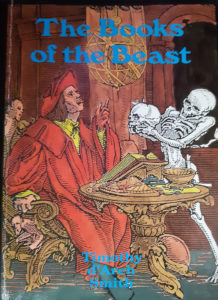
The Books of The Beast
Timothy d’Arch Smith
Format: Softcover
ISBN 9781869928179
£12.99/US$22
Subjects: Aleister Crowley/Crowleyiana/Publishing History/Antiquarian Books/Occult.
Timothy d’Arch Smith is a well-known bibliographer, reviewer and antiquarian bookseller with a special interest in the by-ways of literature, notably the occult and the curious.
For Aleister Crowley a book was a talisman and their every part right down to colour, dimension, and price was symbolic. He also used magical techniques to gain literary success–thus new editions of Crowley’s writing multiply daily, tantalizing the bibliographer. All the more indispensable is this authoritative guide to his magical first editions.
Timothy d’Arch Smith, widely acknowledged as a leading expert on Crowley and on underground literature, offers several shorter articles on:
*Oxford’s demonologist Montague Summers;
*R A Caton and his Fortune Press;
*Sexual prophet Ralph Chubb;
*Florence Farr;
*The British Library Private Case;
*and Timothy d’Arch Smith.
*For this new edition, he also adds an extra chapter on Crowley.
REVIEWS
”…one could hardly wish for a more stimulating guide…” –The London Magazine
”One of the more immediately striking things about the book is its gentle humour.”- Time Out
The Books of The Beast. Timothy d’Arch Smith. (Mandrake).
The author of this collection of studies of twentieth-century occultists is a well-known antiquarian bookseller, bibliographer and reviewer with a life-long interest in esoterica and erotica. This collection has a bibliography of Crowley that gives the book its title and biographies of the Roman Catholic priest, playwright, schoolmaster, collector of homoerotic pornography, demonologist and closet Satanist, Montague Summers, the eccentric R.A. Caton, who shared Summer’s interest in young boys and was briefly his publisher, Ralph Chubb, writer, artist and pederast who tried to create a new religion based on the worship of a boy-god, and pioneering female occultist Florence Farr of The Hermetic Order of The Golden Dawn. There is also an account of Crowley’s disguised appearance as a character in Anthony Powell’s famous novel A Dance to the Music of Time (1951), one of many he made in fictional works, and a description of the private collection of erotica in the British Library. The book concludes with a fascinating autobiographical epilogue on the author’s adventures in the London occult scene of the 1950s and 1960s. These feature Michael Houghton from the Atlantis Bookshop (compared by the author to Grumpy in Walt Disney’s Snow White and The Seven Dwarfs because of his stature and demeanour!), Crowley’s forgotten biographer and cricket fan Charles Richard Cammel, who died during a Test Match at the Oval (what a way to go!), the writer and biographer Jean Overton Fuller, the Beatles (who attended a witchcraft exhibition organised by the author), and Crowley follower Jimmy Page of Led Zeppelin. Highly recommended.
The Cauldron # 136, May 2010.
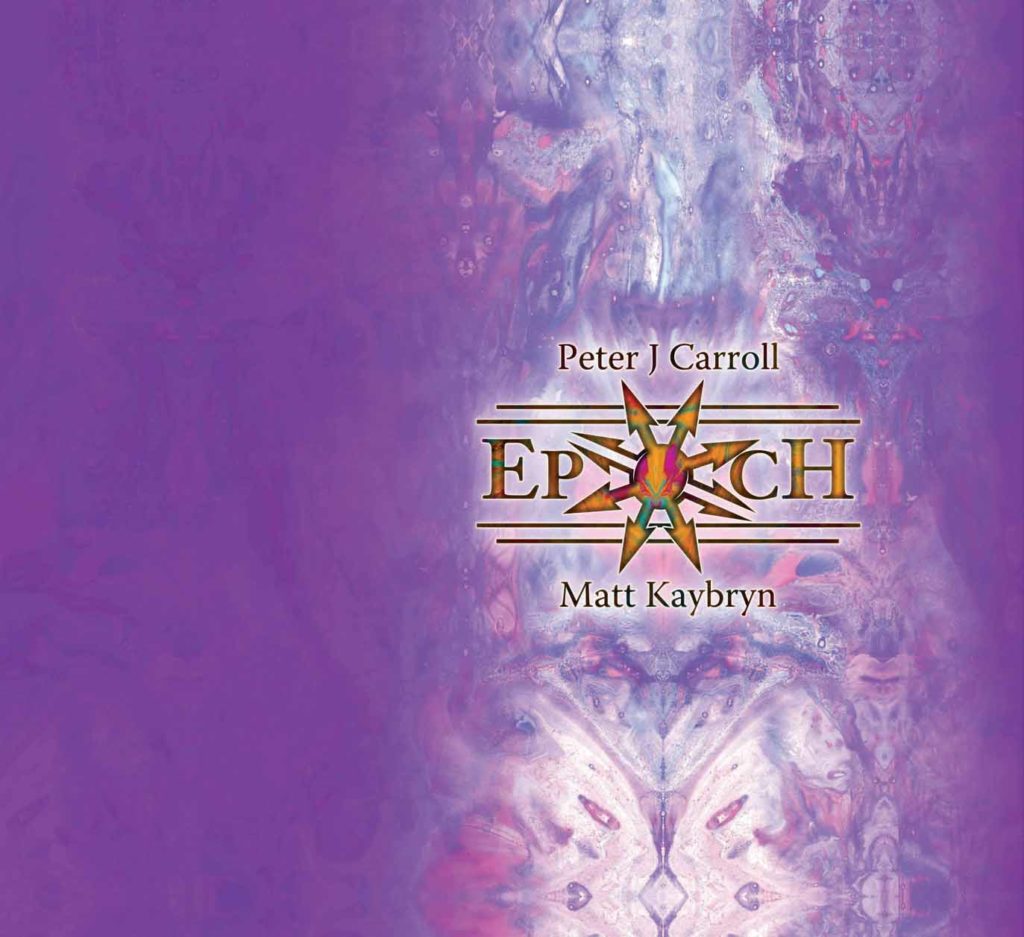
By Peter Carroll and Matt Kaybryn
The Epoch – Hardbound Folio Book & Altar Icon Card Deck.
The Book: This fully illustrated and illuminated hardback opens with a detailed historical resume of magical and esoteric thought (where it came from and where it may go) before presenting the reader with three complete grimoires.
The Deck: A Cartomagical tool for the 21st century, the Deck presents 54 glorious Altar Icons spanning the three Spheres of Elements, Bi-Planets and Stellar god-forms. Hardcover: 216 pages, 28cmx23cm
Publisher: Arcanorium College (21 Mar 2014)
ISBN-10: 0992848822
ISBN-13: 978-0992848828
UK Price – Elsewhere, use same buttons, see below for guide to worldwide postage.
Book £40.00+p&p Click HERE
Deck £15.00 (VAT inc)+p&p Click HERE
Both for £50.00+p&p Click HERE
Postage outside UK is expensive as this is a premium book, could be an additional 50% of order total, eg it costs about £40 to send both items, we will contact you with the actual cost, and refund if preferred. Why not start with the book and come back for the cards if you find you need them, it works out same postage wise
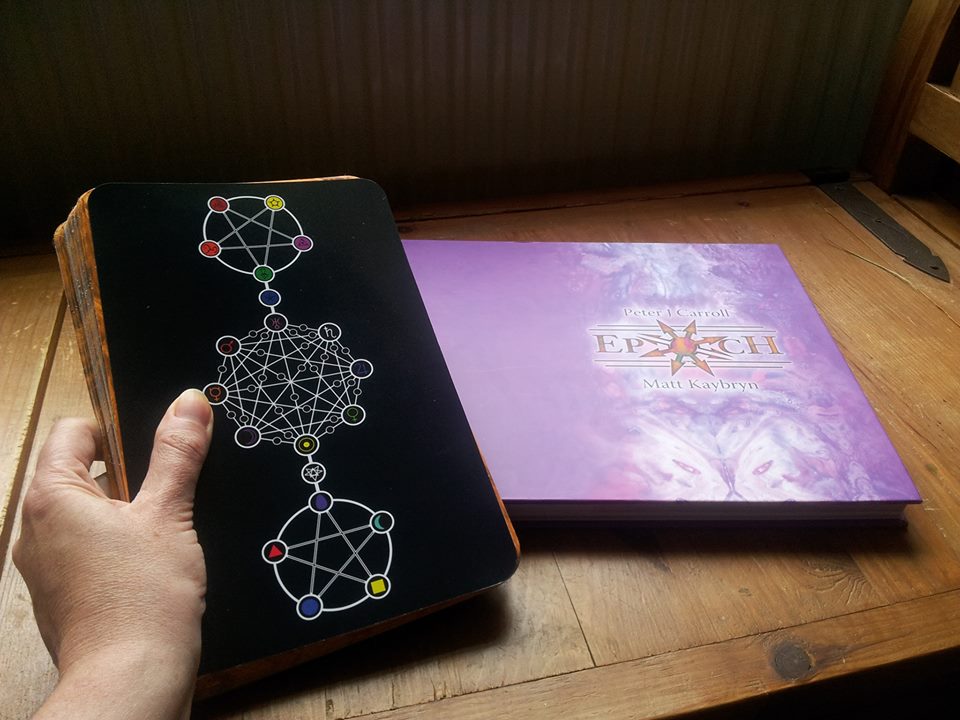
” This really is a pantheon for the present day: up-to-date technowizard
artwork, a commentary which soars over millennia of tradition, picking out
what is useful and relevant at the present, and icons which sum up what
deities from the whole span of Western and not-so-Western culture have
cumulatively come to mean. This is a book to which goddesses and gods,
historically so sensitive about their images, should be happy to belong.”
Professor Ronald Hutton – Fellow of the British Academy
” Not content to release a new grimoire, the Chancellor of Arcanorium College has produced three. Oh, also, one of them is a Necronomicon.
Elemental, Planetary, and Lovecraftian grimoires are joined by an accompanying tome of digitally and painstakingly rendered icons. The Portals of Chaos, and its Chaobala systemisation, marks a particularly cohesive collection of Carroll’s work. But it also contains much exciting new material. Exploration of bi-planetary sorcery – a central component of Renaissance magic somewhat absent in modern occult discourse – is a particularly important feature.
Epoch is a useful resource both for those just starting out and for experienced magicians. There is something here to excite and challenge
occultists of many different dispositions and practices. ” Alexander Cummins – Author of ‘The Starry Rubric’
“The enormous scope of the theory expounded within, coupled with the extraordinary pictures (which are better than anything of this ilk since Freida got down with her paintbrushes), provoke many thoughts as well as providing a neat summary of some complex ideas. Simultaneously a history and a prediction, it casts a spell covering spacetime and beyond, allowing your magick to have results.” Nikki Wyrd -Author of ‘The Book of Baphomet’
Pulled together, it is a fantastic cohesion of ideas in need of cohering, doubly so because the cohesion makes no claims to antiquity and doesn’t have to fit with either Neoplatonic emanations or Sanskrit body centres. Getting your head around the Chaobala is getting your head around a substantially updated magical cosmology. If that kind of thing is your jam, this kind of book is your toast. Gordon White – Runesoup
Without a doubt, the Epoch will have a great influence on the chaos magick paradigm and modern magick in general for years to come. I think every magician, even if they have their own correspondences, should examine the Chaobola system for its elegance and breadth. James Wilber – Scroll of Thoth
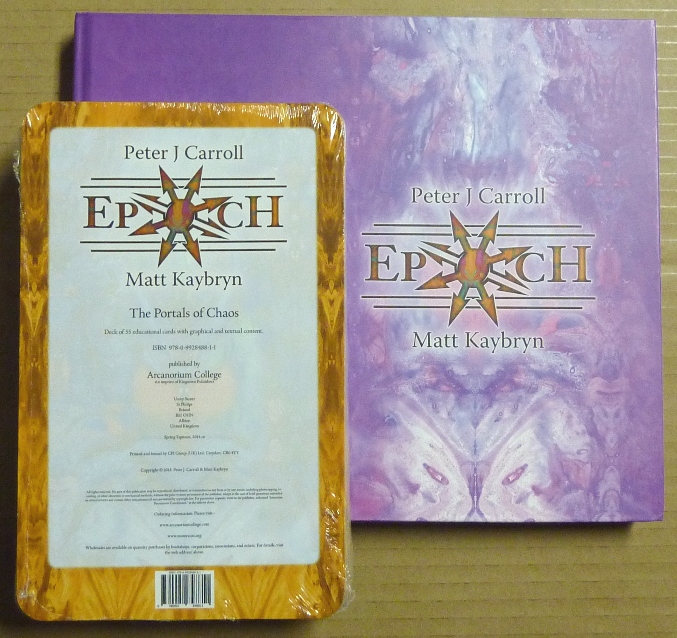
Peter Carroll

The Great Purple Hoo-Ha part I
Philip H. Farber
Format: Softcover
ISBN: 978-1-906958-16-9
£9.99/US$14.99
Subjects: Fiction/Magick/NLP.
‘Farber’s writing is a joyride through the psyche. Absurdity and the internal workings of our own beliefs are less than a hair’s width apart – and Farber illustrates this with inimitable style, humor, and a kitschy sense of self- referential pseudo-realism.’
– LaSara Firefox Allen, MPNLP,
Developer of Gratitude Games and author of Sexy Witch
Special Offer:
GPHH Part 1&2 for Only £12.99+p&p
GPHH Part 1&2 for Only $22.00+p&p
‘As blatant propaganda, The Great Purple Hoo-Ha is funnier than Catholicism and slightly less disgusting than ads for colonic irrigation.’
— Ivan Stang,
Church of the Subgenius
‘A surreal, submodalicious page turner that will have you leaping from the written words to your own life in a joyous celebration and an aching wish for your own Hoo-Ha.’
— Donald Michael Kraig,
author of Modern Magick and The Resurrection Murders.
”From a magicko-religious point of view I’d say, ‘The Great Purple Hoo-Ha proves that changing Perception is the Great Work’. From a reader’s perspective I’d say, ‘It’s like Stranger in a Strange Land except much funnier and with hotter sex.’ From a friend’s perspective I’d say, ‘Dude, you should buy this!'”
— Don Webb, author of Aleister Crowley: The Fire and the Force and Uncle Setnakt’s Essential Guide to the Left Hand Path.
‘Joe had a drinking problem. The possible demise of his television talk show and the end of his career had tilted a very big bottle of Old Mystery into his guts.
Now he was having trouble telling where the hallucinations ended and reality began. Had the mysterious young man with the cat – whom nobody else could see – really granted him a magical wish for fame and fortune?
Were the sex-obsessed cultists he was investigating on the show really bringing on the End of the World? Where did the sentient cream-filled pastries come from? Who was the Most Disgusting Rock Star Ever?
And, more importantly, would Joe ever get his new girlfriend, the Goddess, into bed?’